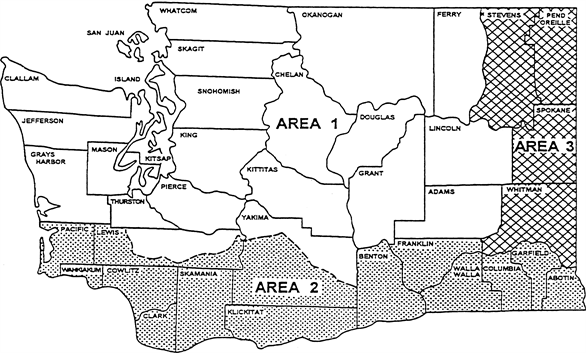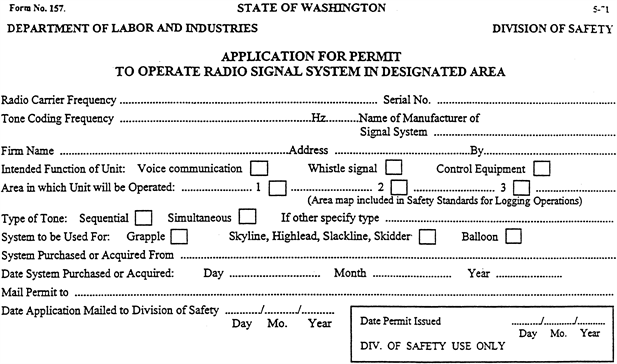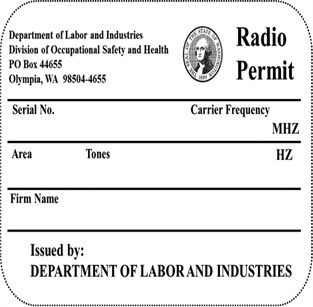PDFWAC 296-54-605
Radio systems used for voice communication, activation of audible signals, or control of equipment.
(1) A valid operating permit must be obtained by the owner from the department of labor and industries, prior to putting into use any radio signaling or control system intended to be used in conjunction with any type of cable logging operations.
(a) Permits will be issued only for systems licensed for such use and using those carrier frequencies as authorized by the Federal Communications Commission.
(b) Permits will be granted only when tone or function frequencies are compatible with other radio systems in use and when in compliance with all other applicable requirements of this chapter.
(2) The department of labor and industries reserves the right to designate the use of radio frequencies for specific purposes or functions. For example: Frequencies may be specified for voice transmission of instruction, others for tone-coded functions, or activation of signaling devices.
(a) Single tone coded functions must not be used on radio equipment designed to initiate whistle signals, or to activate or control any machine, material-handling device, or other equipment hazardous to employees.
(b) The department may also designate which tone frequencies may be used for the activation of a signaling device or for control of equipment on certain federal communication assigned carrier frequencies.
(3) A list of tone frequencies that may be used with any Federal Communications Commission assigned carrier frequencies will be made available from the department upon request.
(4) The department will assign the area or areas in which a radio signaling system may be used and mark those areas on the permit. Radio signaling systems must not be used in any area other than the ones indicated on the permit. (See Figure 36: Areas for Use of Radio Signaling Systems for Logging Operations.)
(5) The person or firm name on the permit must be the same as the person or firm operating the radio signaling system except for loaner or rental sets. A person or firm using a loaner or rental set is responsible for the radio signal system as if they were the owner of the set.
(6) The application for a permit to use a radio signaling system must contain the following information (see Figure 37: Application for permit to operate radio signal system in designated area):
(a) Name and address of applicant.
(b) The radio frequencies of the radio signaling device in MHz.
(c) The tone frequencies of the radio signaling system used to activate a horn, whistle, or control equipment in Hz. The security gate, or pulse tone, must be shown first.
(d) The name of the manufacturer of the radio signaling system.
(e) The serial number of the receiving unit.
(f) The state assigned area or location in which the unit will operate.
(g) The type of signaling used.
(h) From whom the system was purchased or acquired, and the date of acquisition of the system.
(i) Intended use and function of the system.
(7) All radio equipment must meet all applicable FCC standards. FCC identifier numbers and required information must be visible when possible.
(8) Radio equipment must not be used without displaying a permit as required by this standard. The permit must be prominently displayed on the outside case of the receiver of the unit or, for radio-controlled carriages, on the transmitter in the yarder.
(9) Each radio receiver must have its radio carrier frequency in MHz and tone frequency(s) in Hz indicated on the outside case of the receiver (see Figure 38: Radio permit):
(a) The manufacturer's name and serial number must be permanently indicated on the outside of the case;
(b) When the duration or width of the tone frequencies performs a function, the one duration/width must also be permanently indicated on the outside of the receiver case;
(c) Each transmitter must be identified with its receiver; and
(d) Two or more receivers in operation simultaneously on the same tone frequencies are prohibited unless one is used for monitoring only.
(10) It will be the responsibility of the owner of any radio signaling system to notify the department of labor and industries, immediately, if the signal system is:
(a) Permanently retired (in what manner and date retired);
(b) Sold (submit name and address of purchaser and date sold);
(c) Removed from the state (name of state to which moved and date moved); or
(d) Stolen (date).
(11) All radio signaling systems put into use for the first time after the effective date of these safety standards, must meet or exceed the minimum performance specifications contained in WAC 296-54-607 of these safety standards, and, when altered or repaired, must continue to meet such specifications.
(12) Adjustments, repairs, or alterations of radio signaling and control devices must be done only by or under the immediate supervision and responsibility of a qualified and certified radio technician with factory training or equivalent certified experience. Anyone without the technical ability or the proper equipment to cause the signaling systems to function within required tolerances must not attempt to repair, alter, or adjust the systems.
(13) When interference, overlap, fadeout, or blackout of radio signals is encountered, the use of the device must be discontinued immediately. Use may not be resumed until the source of trouble has been detected and corrected.
(14) Radio frequencies assigned to systems for which voice communications may be used to give signals to the yarder operator must not be the same frequencies as those assigned for whistle signals or machine control signals used in skyline, highlead, slackline, or cable skidder systems.
(15) When hazardous interference is created by moving a voice communication system into an area where a system is already in use on the same frequency, use of the newly moved system must be immediately discontinued until the problem of interference has been corrected.
(16) Before moving any unit from one assigned geographical area to another (see area map, Figure 36: Areas for Use of Radio Signaling Systems for Logging Operations), the owner must apply for and receive a new permit from the department.
areas for use of radio signaling systems for logging operations
 |
state of washington department of labor and industries division of industrial safety and health Figure 36: Areas for Use of Radio Signaling Systems for Logging Operations |
 |
Figure 37: Application for Permit to Operate Radio Signal System in Designated Area |
 |
Figure 38: Radio Permit
A permit issued by the department of labor and industries shall be attached to the outside of the receiver which shall indicate the area in which the radio signaling equipment may be used.
[Statutory Authority: RCW 49.17.010, 49.17.040, 49.17.050, 49.17.060, and chapter 49.17 RCW. WSR 17-17-131, § 296-54-605, filed 8/22/17, effective 10/22/17. Statutory Authority: RCW 49.17.010, [49.17].040 and [49.17].050. WSR 99-17-117, § 296-54-605, filed 8/18/99, effective 12/1/99. Statutory Authority: RCW 49.17.040, [49.17].050 and [49.17].060. WSR 96-22-013, § 296-54-605, filed 10/28/96, effective 1/1/97. Statutory Authority: Chapter 49.17 RCW. WSR 88-23-054 (Order 88-25), § 296-54-605, filed 11/14/88. Statutory Authority: RCW 49.17.040, 49.17.150 and 49.17.240. WSR 79-10-081 (Order 79-14), § 296-54-605, filed 9/21/79.]